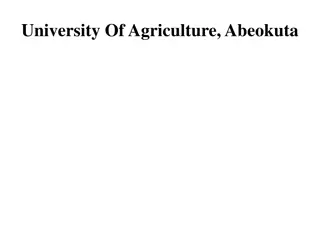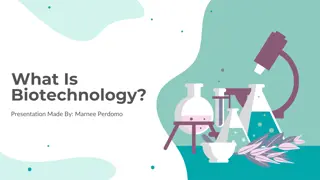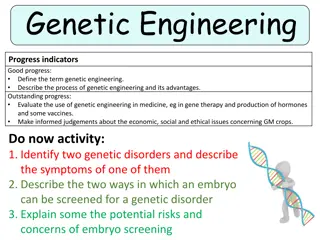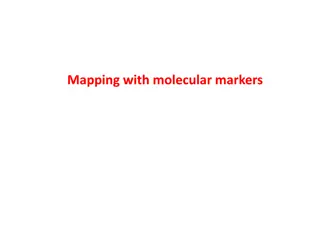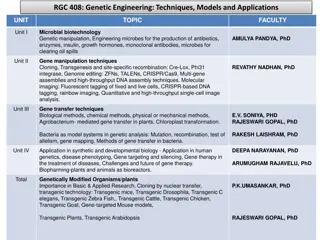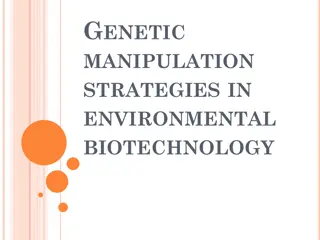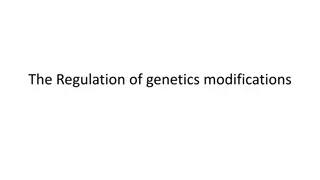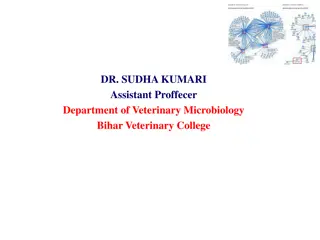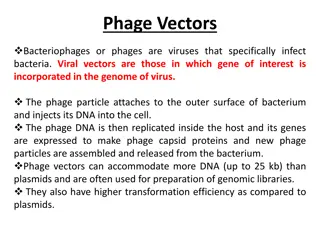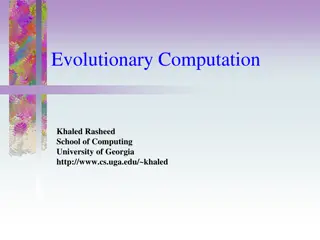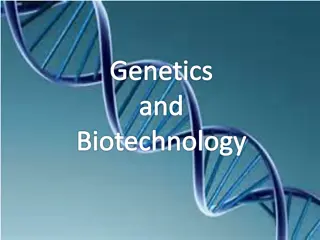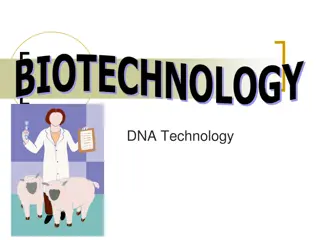BCH 462- Biotechnology & Genetic engineering [Practical]
Explore the practical application of restriction enzymes and genetic polymorphism in biotechnology and genetic engineering labs. Learn about the differences in DNA sequences among individuals, the role of restriction enzymes in creating genetic variation, and the impact on DNA fragment sizes. Discover how genetic polymorphism influences restriction endonuclease recognition sites and DNA fragment lengths.
Download Presentation

Please find below an Image/Link to download the presentation.
The content on the website is provided AS IS for your information and personal use only. It may not be sold, licensed, or shared on other websites without obtaining consent from the author.If you encounter any issues during the download, it is possible that the publisher has removed the file from their server.
You are allowed to download the files provided on this website for personal or commercial use, subject to the condition that they are used lawfully. All files are the property of their respective owners.
The content on the website is provided AS IS for your information and personal use only. It may not be sold, licensed, or shared on other websites without obtaining consent from the author.
E N D
Presentation Transcript
BCH 462- Biotechnology & Genetic engineering [Practical] Lab (7) Restriction Fragment Length Polymorphism (RFLP)
Restriction enzymes [R.E] Arestriction enzyme is a DNA-cutting enzyme that recognizes specific sites in DNA. Are found in bacteria (and other prokaryotes). They recognize and bind to specific sequences of DNA, usually 4 8 bp in length, called restriction sites. Because they cut within the molecule, they are often called endonucleases. Each restriction enzyme recognizes just one or a few restriction sites. A restriction enzyme will make a double-stranded cut in the DNA molecule. Pause and Think why restriction enzymes were originated in bacteria? 1- Sticky ends 2- Blunt ends
Genetic polymorphism is a difference in DNA sequence among individuals. Polymorphisms and genetic variations Individuality in humans and other species derives from their genetic polymorphism. Genetic polymorphism is defined as the inherited genetic differences among individuals in over 1% of normal population. Pause and Think How gene polymorphism is different from gene mutation? Homologous human chromosomes differ in sequence, on average, every ~1250 bp. Father Mother Homologous Chromosomes
These genetic differences create and eliminate restriction sites. 1- Restriction site can be created 1.a In normal state T A 1.b In disease 2- Restriction site can be eliminated A T 2.b In disease 2.a In normal state
Same Chromosome (Allele I) (Allele II) Remember Every person has two copies of each gene, one inherited from each parent.
Polymorphisms and genetic variations Some of the sequence changes affect recognition sites for restriction enzymes, resulting in variation in the size of DNA fragments produced by digestion with a particular restriction enzyme. The distance between the cleavage sites of a certain restriction endonuclease differs between individuals. The length of the DNA fragments. The number of resulting DNA fragments differs. (Allele I) (Allele II)
Same Chromosome (Allele I) (Allele II) 3 kb 4 kb 1 kb 4 kb 3 kb 1 kb Genetic polymorphism can create or abolish restriction endonuclease (RE) recognition sites, thus affecting quantities and length of DNA fragments resulting from RE digestion.
Restriction fragment length polymorphism (RFLP) Restriction Fragment Length Polymorphism (RFLP) is a technique in which organisms may be differentiated by analysis of patterns derived from cleavage of their DNA. Restriction fragment length polymorphism (RFLP) is an inherited difference in the pattern of restriction, which is type of polymorphism that results from variation in the DNA sequence. Simply, the variations in the restriction DNA fragments length between individuals of a species is called RFLP. It was invented in 1984 by the English scientist Alec Jeffreys. RFLPs may disrupt the function of the gene or may have no biologic consequences depending on their occurrences at known gene loci and/or in sequences that have no known function.
Cleaving site for same restriction enzymes A/B B/C C/D D/D A/A 4 kb Allele A 5 kb Allele B 2.5 kb Allele C 4.5 kb Allele D DNA samples from five individual mice were digested with the same restriction enzyme.
Principle 1. Restriction endonucleases cut long DNA into short fragments. 2. Each restriction endonuclease targets different nucleotide sequences (restriction site). 3. The distance between the cleavage sites of a certain restriction endonuclease differs between individuals. 4. Hence, the length of the DNA fragments will differ across both individual organisms and species.
RFLP workflow 1st DNA Extraction. 2nd Perform PCR for the region of interest. not always 3rd DNA Fragmentation by RE. 4th Gel Electrophoresis. 5th Blotting Southern blot procedure . 6th Hybridization of membrane to a labeled DNA probe 7th Visualization of Bands.
RFLP steps The first step in this process is to isolate the DNA from the target. 1. Once the the DNA is isolated from the sample it is subjected to restriction digestion using restriction enzymes. 2. The digested DNA sample is then subjected to gel electrophoresis, in which the DNA is separated based on its size. 3. Many DNA fragments with slight differences in length are produced. The gel is then exposed to a chemical to denature double-stranded DNA to become single- stranded. 4. This is followed by Southern blotting where DNA is transferred from gel to nylon membrane. 5. The nylon membrane is then exposed to solution with radioactive complementary nucleotide probes that hybridize to 6. specifically chosen DNA sequences on nylon membrane. The membrane is then placed against X- ray film, where hybridized radioactive probes cause exposure of X-ray film, 7. producing an autoradiogram. RFLP analysis is carried out to detect differences in pattern to confirm polymorphisms. 8.
Applications of RFLP I. It can be used as a vital tool in genome mapping II. Genetic disease analysis such as cystic fibrosis and sickle cell anemia. III. It is useful in genetic fingerprinting and the identification of samples retrieved from crime scenes (forensic applications). IV. It has a role in the determination of paternity cases and the source of a DNA sample. V. It can be used to determine the disease status of an individual (i.e. mutations detection).
Example of using RFLP in the detection of sickle cell anemia A T of the -globin gene Legend Heterozygote (carrier) Homozygote Female Fetus Male
Example of using RFLP in the detection of phenylketonuria PKU is inherited in families in an autosomal recessive pattern. What is the expected disease status of the children/fetus ? Allele a. Normal PAH gene 3 5 5 kb Cleaving site for restriction enzymes Allele b. Mutant PAH gene 5 3 5 kb 3 kb 2 kb 3 kb 2 kb Legend Affected Female Fetus Male Carrier
Example of using RFLP in the detection of phenylketonuria PKU is inherited in families in an autosomal recessive pattern. What is the expected disease status of the children/fetus ? Allele a. Normal PAH gene 3 5 5 kb Cleaving site for restriction enzymes Allele b. Mutant PAH gene 5 3 5 kb 3 kb 2 kb 3 kb 2 kb Legend Affected Female Fetus Male Carrier
Examples of using RFLP in criminal investigations One the basis of this test, which suspect is considered to be guilty of crime? loci
How is the father of the identical twins?
![BCH 462- Biotechnology & Genetic engineering [Practical]](https://cdn1.slideorbit.com/273367/bch-462-biotechnology-genetic-engineering-n.jpg)



